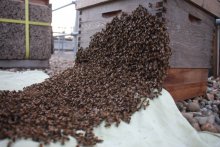All central hives appear to be well
I've been visiting the hives in central Oxford every couple of weeks. There is still evidence of activity on the base board in all 6 hives (chewed cappings; dead Varroa; etc). I believe that they're all still alive and ok.
There are causes for concern though. All the hives have visible numbers of dead bees at their entrances. I don't know whether these were healthy bees which were stranded during cold weather or whether they were virus infected bees which crawled out of the hive. I presume the latter.
- Read more about All central hives appear to be well
- Log in or register to post comments
